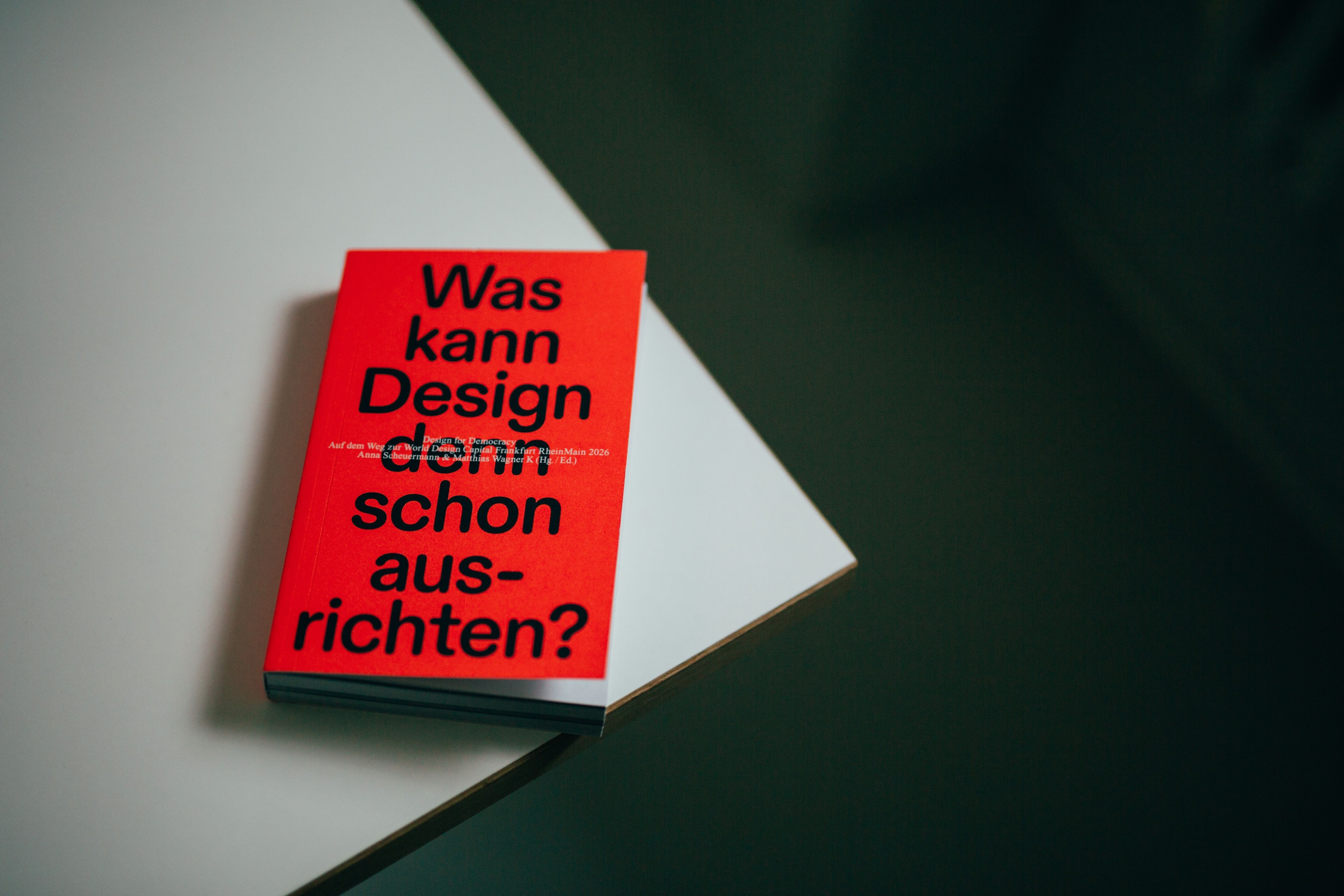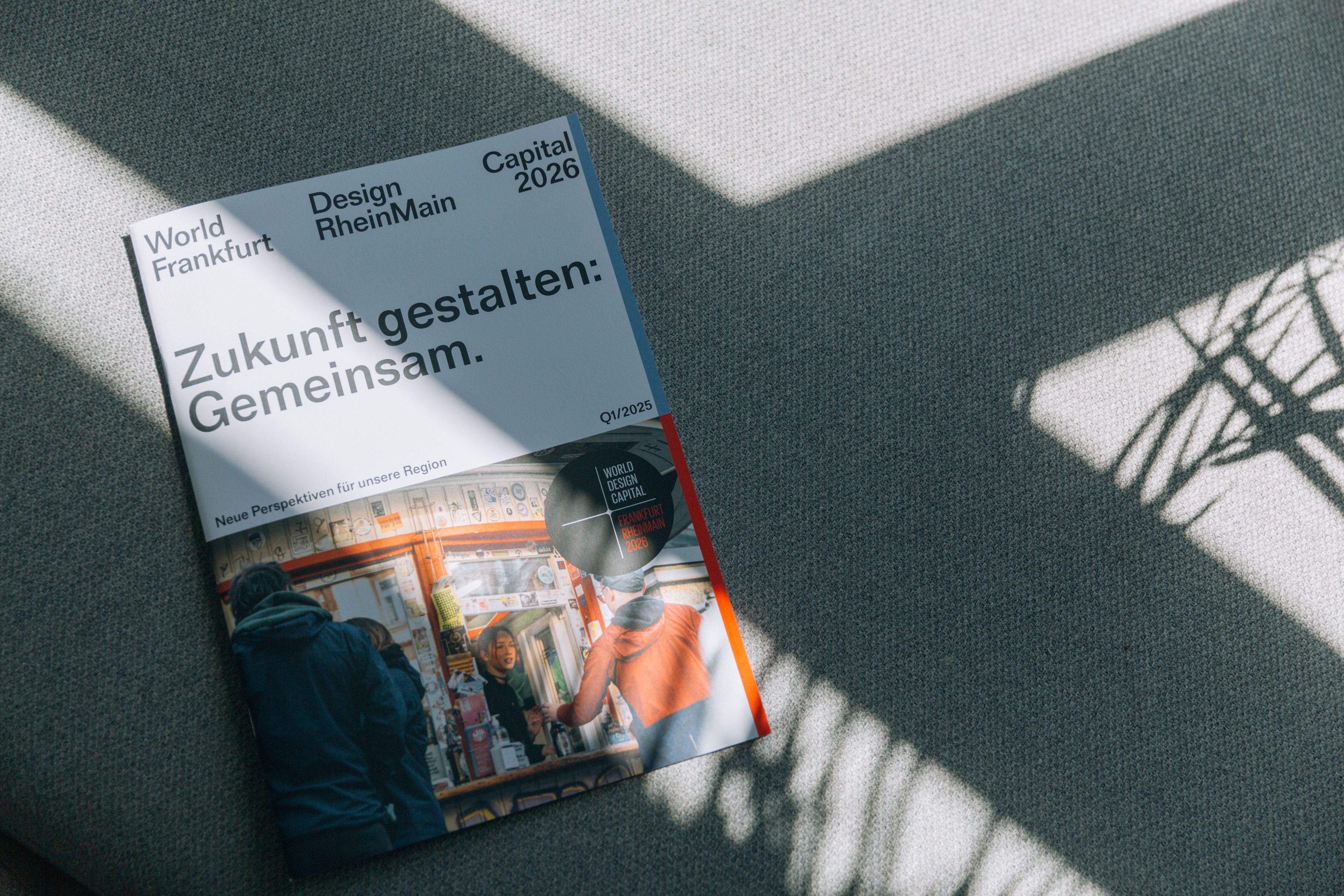 ©Ben Kuhlmann
©Ben KuhlmannPublications
Publications by and on key themes of WDC 2026
Reading List
The following reading list brings together texts that shape our expanded understanding of design. They provide insights into the perspective that defines our edition of the World Design Capital 2026 in Frankfurt RheinMain: design is not only about form-making, but a tool for social transformation.
The selected titles open up perspectives on how design influences our living environments, enables new forms of community, and accompanies processes of change. They provide both theoretical impulses and practical approaches that demonstrate how design can contribute to strengthening democracy, participation, and sustainable futures – forming a foundation for shared reflection and action within WDC 2026.
The selection is organised by thematic categories: it ranges from political theory, aesthetics and design, to design criticism and questions of ideology, through to approaches such as social design, public interest design and speculative design. Plural and postcolonial perspectives are included, as are reflections on design ethics, responsibility and the shaping of public spaces and infrastructures. The list is complemented by literature on democratic theory and the current crises of democracy – and not least by children’s books, which in their own way open up new perspectives.
WDC 2026 Reader
The Frankfurt RheinMain region has won the title of World Design Capital 2026 with the theme Design for Democracy. Atmospheres for a Better Life. In this context, the reader explores the power of design to shape collective processes, develop solutions and drive social change. By addressing key areas such as Work, Construction & Housing, Education, Health, Industry, Consumption, Culture & Media, Mobility, Public Space and Sports, the authors illustrate how design intersects with everyday life.
Wagner K, Matthias, & Scheuermann, Anna (Eds.) (2025). Design for Democracy: Atmospheres for a better life, Reader. Stuttgart: av edition.
Political Theory, Aesthetics and Design
Design is never neutral. It is always an expression of an attitude – whether implicit or explicit, affirmative or critical, conforming or resistant. In a time when democratic principles are increasingly under pressure, the political dimension of design is once again both visible and urgent. The section Political Theory, Aesthetics and Design brings together key contributions that highlight this political dimension of design and provide it with a solid theoretical foundation.
Adorno, Theodor W. (2010). Funktionalismus heute (1965). In K. T. Edelmann ; G. Terstiege (Eds.), Gestaltung denken: Grundlagentexte zu Design und Architektur (S. 147–161). Basel: Birkhäuser.
Bonsiepe, Gui (2006). Design and democracy. Design Issues, 22(2), 27–34.
von Borries, Friedrich (2016). Weltentwerfen: Eine politische Designtheorie. Berlin: Suhrkamp.
Erlhoff, Michael, & Rezai, Maziar (Eds.) (2022). Design & Democracy: Activist Thoughts and Examples for Political Empowerment. Basel, Switzerland: Birkhäuser.
Geiger, Annette (2018). Andersmöglichsein: Zur Ästhetik des Designs. Bielefeld: Transcript Verlag.
Kaya, Çiğdem (2010). Emerging concepts of democracy in design in the 20th century. Design Principles & Practices: An International Journal, 4(5), 1–8.
Kosok, Felix (2021). Form, Funktion und Freiheit: Über die ästhetisch-politische Dimension des Designs, Bielefeld: transcript.
Latour, Bruno (2010). Ein vorsichtiger Prometheus? Einige Schritte hin zu einer Philosophie des Designs, unter besonderer Berücksichtigung von Peter Sloterdijk. In M. Jongen, S. van Tuinen, & K. Hemelsoet (Eds.), Die Vermessung des Ungeheuren: Philosophie nach Peter Sloterdijk (S. 356–373). München: Fink.
Manzini, Ezio, & Margolin, Victor (2017). Stand up for democracy. Abgerufen von http://www.democracy-design.org/open-letter-stand-up-democracy/
Miessen, Markus (2016). Crossbenching. Leipzig: Merve Verlag.
Mitchell, W.J.T. (2012). Das Leben der Bilder. Eine Theorie der visuellen Kultur. München: C.H. Beck Verlag.
Rancière, Jacques (2005). Die Fläche des Designs. In ders., Politik der Bilder. Berlin: Diaphanes.
Wellmer, Albrecht (1985). Kunst und industrielle Produktion: Zur Dialektik von Moderne und Postmoderne. In ders., Zur Dialektik von Moderne und Postmoderne: Vernunftkritik nach Adorno (S. 115–131). Frankfurt am Main: Suhrkamp.
Design & Ideology [Design Critique]
Design is never innocent. Every interface, every product, every visual language inscribes itself into social contexts – into power relations, norms, and worldviews. This section brings together contributions that examine design through the lens of ideological critique: as a cultural practice that not only reflects the world but actively co-constructs it – and, in doing so, conveys interests, exclusions, and contradictions.
Colomina, Beatriz, Brennan, Mark Wigley, & Buckley, Craig (Eds.). (2018). Superhumanity: Design of the self. Minneapolis: University of Minnesota Press.
Dourish, Paul (2018). Ideology and interpellation: Althusser’s “Ideology and ideological state apparatuses.” In J. Bardzell, S. Bardzell, & M. Blythe (Eds.), Critical theory and interaction design (pp. 407–416). Cambridge, MA: MIT Press.
Fry, Tony (2010). Design as Politics. Berg Publishers / Bloomsbury Publishing.
Gronert, Siegfried, & Schwer, Thilo (Eds.) (2018). Designkritik: Theorie, Geschichte, Lehre. Stuttgart: av edition.
Haug, Wolfgang Fritz (2009). Kritik der Warenästhetik: Gefolgt von Warenästhetik im High-Tech-Kapitalismus. Frankfurt am Main: Suhrkamp.
Kaiser, Anja, & Stephany, Rebecca (Eds.). (2021). Glossary of Undisciplined Design. Spector Books.
Keshavarz, Mahmoud (2021). Design-politics: An inquiry into passports, camps and borders. Bloomsbury Visual Arts.
Lorusso, Silvio (2018). Entreprecariat: Everyone is an entrepreneur. Nobody is safe. Amsterdam: Institute of Network Cultures.
Lorusso, Silvio (2023). What Design Can’t Do: Essays on design and disillusion. Lisbon: Set Margins’.
Miessen, Markus (2010). The Nightmare of Participation: Crossbench Praxis as a Mode of Criticality. London: Sternberg Press.
Miessen, Markus; Ritts, Zoë (2020). Para-Plattformen: die Raumpolitik des Rechtspopulismus, Leipzig: Merve Verlag.
Offermanns, Ingo (Ed.) (2022). Graphic Design Is (…) Not Innocent. Valiz.
Papanek, Victor (1971). Design for the real world: Human ecology and social change. Pantheon Books.
Pater, Ruben (2016). The politics of design: A (not so) global design manual for visual communication. Amsterdam: BIS Publishers.
Pater, Ruben (2021). CAPS LOCK: How capitalism took hold of graphic design, and how to escape from it. Amsterdam: Valiz.
Selle, Gert (1973). Ideologie und Utopie des Design: Zur gesellschaftlichen Theorie der industriellen Formgebung. Köln: DuMont.
Stolterman, Eric (2018). Herbert Marcuse and the “One-Dimensional Man.” In J. Bardzell, S. Bardzell, & M. Blythe (Eds.), Critical theory and interaction design (pp. 357–370). Cambridge, MA; London: MIT Press.
Žižek, Slavoj (2018). The seven veils of fantasy (1997). In J. Bardzell, S. Bardzell, & M. Blythe (Eds.), Critical theory and interaction design (pp. 37–41). Cambridge, MA; London: MIT Press.
Design Activism / Social Design / Public Interest Design
Design is not only a reaction – it can also be resistance, vision, and intervention. This section explores forms of design that take social responsibility seriously and actively contribute to social change. These texts show how design can represent public interests, make grievances visible, test alternatives, and strengthen collective agency.
Adbusters, & Lasn, Kalle (2013). Meme Wars: The Creative Destruction of Neoclassical Economics. New York: Seven Stories Press.
Banz, Claudia (Ed.) (2018). Social Design: Gestalten für die Transformation der Gesellschaft. Bielefeld: Transcript.
Baur, Ruedi, & Baur, Vera (Eds.) (2017). Our World to change! Civic city and Attac. Lars Müller Publishers.
Berliner Festspiele mit Gropius Bau (Eds.) (2024): Radical Play book. From Competition to Collaboration. Erschienen anlässlich des Projekts Radical Playgrounds. Ein Kunstparcours am Gropius Bau. Kuratiert von Joanna Warsza & Benjamin Foerster-Baldenius, Architektur von raumlaborberlin. Berliner Festspiele.
Bieling, Tom (Ed.) (2019). Design (&) Activism: Perspectives on design as activism and activism as design. Berlin: Mimesis International.
Costanza-Chock, Sasha (2020). Design justice: Community-led practices to build the worlds we need. Cambridge, MA; London: MIT Press.
DiSalvo, Carl (2022). Design as Democratic Inquiry. MIT Press.
Feige, Daniel Martin (2019). Zur Dialektik des Social Designs: Ästhetik und Kritik in Kunst und Design (Studienhefte: Problemorientiertes Design, Heft 9). Hamburg: Adocs.
Fezer, Jesko (2018). Parteiisches Design. In: Rodatz, C. & Smolarski, P. (Eds.), Was ist Public Interest Design? (S. 161–170). Bielefeld: Transcript.
Fuad-Luke, Alastair (2009). Design Activism: Beautiful Strangeness for a Sustainable World. Earthscan.
Manzini, Ezio (2019). Politics of the Everyday. Bloomsbury.
Milk (Ed.) (2022). Meanwhile City. How temporary interventions create welcoming places with a strong identity. Published by Milk.
Moebius, Stephan, & Prinz, Sophia (Eds.). (2012). Das Design der Gesellschaft: Zur Kultursoziologie des Designs. Bielefeld: Transcript.
Pfeffer, Florian (2014). To Do: Die neue Rolle der Gestaltung in einer veränderten Welt: Strategien, Werkzeuge, Geschäftsmodelle. Mainz: Hermann Schmidt Verlag.
Resnick, Elizabeth (Ed.) (2019). The Social Design Reader. London: Bloomsbury Visual Arts.
Rodatz, Christoph, & Smolarski, Pierre (Eds.) (2018). Was ist Public Interest Design? Beiträge zur Gestaltung öffentlicher Interessen. Bielefeld: Transcript Verlag.
Schneidewind, Uwe (2018) Die Große Transformation Eine Einführung in die Kunst gesellschaftlichen Wandels. FISCHER Taschenbuch.
Schranz, Christian (Ed.) (2023). Commons in Design. Amsterdam: Valiz.
Smith, Cynthia (Ed.) (2007). Design for the other 90 percent. Smithsonian Institution, Cooper-Hewitt National Design Museum.
Tromp, Nyke, & Hekkert, Paul (2019). Designing for society: Products and services for a better world. London: Bloomsbury Visual Arts.
Weibel, Peter (Ed.) (2015). global aCtIVISm. Art and Conflict in the 21st Century. Cambridge/Mass.: The MIT Press.
Critical and Speculative Design
Design does not only improve, beautify or simplify – it can also question, unsettle, and disrupt. The section Critical and Speculative Design highlights approaches that do not simply serve existing systems but deliberately undermine, provoke, or break them open. This form of design asks: What if...? – and develops thought experiments for alternative futures.
DiSalvo, Carl (2012). Adversarial Design. MIT Press.
Dunne, Anthony, & Raby, Fiona (2013). Speculative everything: Design, fiction, and social dreaming. Cambridge, MA; London: MIT Press.
Groß, Benedikt, & Mandir, Eileen (2022). Zukünfte gestalten. Spekulation, Kritik, Innovation. Mit Design Futuring Zukunftsszenarien strategisch erkunden, entwerfen und verhandeln. Mainz: Verlag Hermann Schmidt.
Laranjo, Francisco (2015). Critical Everything. In, Modes of Criticism 4.
Malpass, Matt (2017). Critical design in context: History, theory, and practice. London; New York: Bloomsbury Academic.
Matos, Afonso (Ed.) (2022). Who can afford to be critical?. Eindhoven: Set Margins’.
Mareis, Claudia, Greiner-Petter, Moritz, & Renner, Michael (Eds.) (2022). Critical by design? Genealogies, practices, positions. Bielefeld: Transcript.
Metahaven (2013). Can jokes bring down governments? Memes, design and politics. Moscow: Strelka Press.
Prado, Luiza, & Oliveira, Pedro (2015). Futuristic Gizmos, Conservative Ideals: On (Speculative) Anachronistic Design. In, Modes of Criticism 1.
Traganou, Jilly (2020). Design and political dissent: Spaces, visuals, materialities. London: Routledge.
Plural and Postcolonial Perspectives
Design never takes place in a vacuum. It is embedded in cultural narratives, geopolitical power relations and historical inequalities. The section Plural and Postcolonial Perspectives brings together contributions that critically illuminate these blind spots in design – consistently questioning and decentring the dominant, Western-shaped history of design.
Abdulla, Danah (2017). Design otherwise: Towards a locally-centric design education curricula in Jordan (Doctoral dissertation, University of London, Goldsmiths College, Design Department).
Ansari, Ahmed, Kiem, Matthew, Prado de O. Martins, Luiza, Vieira de Oliveira, & Pedro J. S. (2018). Three perspectives on decolonising design education. PARSE Journal, (8), Exclusion.
Berry, Anne H.; Collie, Kareem; Laker, Penina Acayo; Noel, Lesley-Ann; Rittner, Jennifer; Walters, Kelly (Eds.) (2022) The Black Experience in Design: Identity, Expression & Reflection. Allworth.
Bieling, Tom, & Brandes, Uta (Eds.). DESIGNABILITIES / Design Research Journal, Issue 07: Design Equity, 01/2025.
Campbell, Andy (2019) Queer X Design: 50 Years of Signs, Symbols, Banners, Logos, and Graphic Art of LGBTQ. Black Dog & Leventhal.
Canlı, Ece (2017). Design history interrupted: A queer-feminist perspective. In M. Van Helvert (Ed.), The responsible object: A history of design ideology for the future (pp. 187–207). Amsterdam: Valiz.
Escobar, Arturo (2018). Design for the pluriverse: Radical interdependence, autonomy, and the making of worlds. Durham, NC; London: Duke University Press.
Fry, Tony (2020). Defuturing: A New Design Philosophy. Bloomsbury.
Lupton, Ellen; Tobias, Jennifer (2021). Extra Bold: A Feminist, Inclusive, Anti-racist, Nonbinary Field Guide for Graphic Designers. Princeton Architectural Press.
Mareis, Claudia, & Paim, Nina (Eds.) (2021). Design struggles: Intersecting histories, pedagogies, and perspectives. Amsterdam: Valiz.
Rendell, Jane; Penner, Barbara & Borden, Iain (2000) Gender, Space, Architecture: An Interdisciplinary Introduction. Routledge.
Unterstab, Anna (2024). Design intersektional unter die Lupe nehmen: Gestaltung als Komplize von Diskriminierung und als widerständiges Werkzeug (Studienhefte problemorientiertes Design, Band 12). Hamburg: Adocs.
Design Ethics and Responsibility
Design plays a decisive role in shaping how we live – and which futures become possible. This section addresses the question of responsibility in design: Which ethical standards matter when design intervenes in social processes? How can a stance be developed beyond market logics, and how can designers engage responsibly with technology, power and the environment?
von Borries, Friedrich, & Fezer, Jesko (2013). Weil Design die Welt verändert … Texte zur Gestaltung. Berlin: Gestalten.
Bridle, James (2020). New Dark Age. Der Sieg der Technologie und das Ende der Zukunft. Bonn: bpb.
Brückner, Ulrike, & Herlo, Bianca (2024). Design als Haltung: Handlungsfelder jenseits des Kommerziellen. Mainz: Verlag Hermann Schmidt.
Mehl, Johanna, & Höfler, Carolin (Eds.) (2023). Attending [to] Futures. Matters of Politics in Design Education, Research, Practice. Hamburg: adocs.
Rawsthorn, Alice (2018). Design as an Attitude. Zürich: JRP | Ringier.
Verbeek, Peter-Paul (2005). What Things Do. Philosophical Reflections on Technology, Agency, and Design. Pennsylvania State University Press.
Designing Public Spaces and Infrastructures
Design has its strongest impact where people come together: in public spaces and in the infrastructures that sustain our lives. This section brings together approaches that demonstrate how spaces and systems shape our perceptions, our agency and our ways of living together – and how design can open up arenas of participation, resistance and collective experimentation.
Baur, Ruedi (Ed.) (2005). Das Gesetz und seine visuellen Folgen. Basel: Lars Müller Publishers.
Baur, Ruedi, & Baur, Vera (2022). Le role du design dans les politiques publiques de la ville. Civic City.
Beaugrand, Andreas, & Smolarski, Pierre (Eds.) (2016). Adbusting. Ein designrhetorisches Strategiehandbuch. Bielefeld: Transcript Verlag.
Boelen, Jan, & Sacchetti, Vera (2014). Designing Everyday Life. Design-Reader zur Biennale of Design BIO 50 in Ljubljana. Zürich: Park Books.
von Borries, Friedrich, Hiller, Christian, Kerber, Daniel, Wegner, Friederike, & Wenzel, Anna-Lena (2012). Glossar der Interventionen. Annäherung an einen überverwendeten, aber unterbestimmten Begriff. Leipzig: Merve.
de Bruyn, Gerd (1996). Die Diktatur der Philanthropen: Entwicklung der Stadtplanung aus dem utopischen Denken. Braunschweig, Wiesbaden: Vieweg.
Heiler, Jörg (2014). Gelebter Raum Stadtlandschaft. Taktiken für Interventionen an suburbanen Orten. Bielefeld: Transcript Verlag.
Mörtenböck, Peter, & Mooshammer, Helge (Eds.) (2011) Space (Re)Solutions. Intervention and Research in Visual Culture. Bielefeld: Transcript Verlag
Stiegele, Juliane (2013 – 2024). UTOPIA TOOLBOX .1-3. Toolbooks.
Design History
To understand the present and future of design, it is worthwhile to look back. This section brings together works that explore influential design movements and figures – from the Bauhaus and Neues Frankfurt to designers such as Ferdinand Kramer and the designs of Braun. The texts and catalogues illustrate how historical approaches and attitudes continue to shape our design culture and provide connections that can inform current debates and developments.
Bürdek, Bernhard E. (2015). Design: Geschichte, Theorie und Praxis der Produktgestaltung. Basel: Birkhäuser.
Cogdell, Christina (2004). Eugenic design: Streamlining America in the 1930s. Philadelphia: University of Pennsylvania Press.
Droste, Magdalena (2019). Bauhaus 1919–1933. Köln: Taschen.
Fischer, Volker, & Hamilton, Anne (Eds.) (1999). Theorien der Gestaltung: Grundlagentexte zum Design (Band 1). Frankfurt am Main: Verlag form.
Gropius, Walter (1967). Die neue Architektur und das Bauhaus: Grundzüge und Entwicklung einer Konzeption. Mainz: Florian Kupferberg.
Gropius, Walter (1967). Apollo in der Demokratie. Mainz: Florian Kupferberg.
Hauffe, Thomas (2014). Geschichte des Designs. Köln: DuMont.
van Helvert, Marjanne (Ed.) (2017). The responsible object: A history of design ideology for the future. Amsterdam: Valiz.
Klemp, Klaus, Weber, Grit, Sellmann, Annika, & Wagner K, Matthias (2019). Moderne am Main 1919–1933 [Ausstellungskatalog]. Stuttgart: Arnoldsche Art Publishers.
Mareis, Claudia (2014). Theorien des Designs zur Einführung. Hamburg: Junius.
Midal, Alexandra. (2019). Design by accident: For a new history of design. Berlin: Sternberg Press.
Moholy-Nagy, László (1947). Vision in motion. Chicago: Paul Theobald.
Muthesius, Hermann, & van de Velde, Henry (1914). Werkbund-Thesen und -Gegenthesen. In Volker Fischer & Anne Hamilton (Eds.), Theorien der Gestaltung: Grundlagentexte zum Design (pp. 36–38). Frankfurt am Main: Verlag form.
Naylor, Gillian (1971). The arts and crafts movement: A study of its sources, ideals and influence on design theory. Cambridge, MA: MIT Press.
Newson, Alex, Suggett, Eleanor, & Sudjic, Deyan (2016). Designer Maker User. London: Phaidon.
Oswalt, Philipp (Ed.) (2019). Hannes Meyers neue Bauhauslehre: Von Dessau nach Mexiko. Basel & Berlin: Birkhäuser.
Pevsner, Nikolaus (1949). Pioneers of modern design: From William Morris to Walter Gropius. New York: Museum of Modern Art.
Riemann, Xenia (2006). Die „Gute Form“ und ihr Inhalt: Über die Kontinuität des sachlichen deutschen Designs zwischen 1930 und 1960. Kritische Berichte, 34(1), 52–62.
Selle, Gert (2007). Geschichte des Design in Deutschland: Aktualisierte und erweiterte Neuausgabe. Campus Verlag.
Walker, John (1992). Designgeschichte: Perspektiven einer wissenschaftlichen Disziplin. München: Klinkhardt & Biermann.
Democratic Theory
Democracy is not a given, but an ever-contested project. The texts in this section explore the foundations of democratic coexistence, questions of representation, plurality, and the tensions between consensus and conflict. They open up theoretical horizons for understanding democracy not just as a form of government, but as a practice that can be actively shaped.
Balibar, Étienne (2008). Historical dilemmas of democracy and their contemporary relevance for citizenship. Rethinking Marxism, 20(4), 522–538.
hooks, bell (2003). Teaching community: A pedagogy of hope. New York: Routledge.
hooks, bell (2025). Art on My Mind: Visual Politics. München: Penguin.
Latour, Bruno (2001). Das Parlament der Dinge: Für eine politische Ökonomie. Frankfurt am Main: Suhrkamp.
Latour, Bruno (2005). Von der Realpolitik zur Dingpolitik oder Wie man Dinge öffentlich macht. Berlin: Merve.
Lefort, Claude (1990). Die Frage der Demokratie. In U. Rödel (Ed.), Autonome Gesellschaft und libertäre Demokratie (S. 281–297). Frankfurt am Main: Suhrkamp.
Marchart, Oliver (2013). Die politische Differenz: Zum Denken des Politischen bei Nancy, Lefort, Badiou, Laclau und Agamben. Berlin: Suhrkamp.
Mouffe, Chantal (2013). Das demokratische Paradox. Wien: Turia + Kant.
Mouffe, Chantal (2014). Agonistik: Die Welt politisch denken. Berlin: Suhrkamp.
Rancière, Jacques (2007). Das Unvernehmen. Politik und Philosophie. Frankfurt am Main: Suhrkamp.
Rancière, Jacques (2008). Zehn Thesen zur Politik. Berlin: Diaphanes.
Rancière, Jacques (2006). Die Aufteilung des Sinnlichen: Die Politik der Kunst und ihre Paradoxien. Berlin: b_books Verlag.
Rebentisch, Juliane (2012). Die Kunst der Freiheit: Zur Dialektik demokratischer Existenz. Frankfurt am Main: Suhrkamp.
Rebentisch, Juliane (2022). Der Streit um Pluralität: Auseinandersetzungen mit Hannah Arendt. Berlin: Suhrkamp.
Saward, Michael (2021). Democratic Design. Princeton University Press.
de Tocqueville, Alexis (2014). Über die Demokratie in Amerika (J. P. Mayer, Ed.). Stuttgart: Reclam.
Weisband, Marina (2024). Die neue Schule der Demokratie: Wilder denken, wirksam handeln. Frankfurt am Main: S. Fischer Verlag.
Crises of Democracy
Where democracies come under pressure, the design of public spaces, communication, and participation becomes particularly important. This section gathers analyses of current crises – from authoritarianism and populism to declining trust. The texts highlight the challenges faced by democratic design and encourage reflection on how design can respond to these developments.
Amlinger, Carolin; Nachtwey, Oliver (2022). Gekränkte Freiheit: Aspekte des libertären Autoritarismus. Suhrkamp Verlag.
Bauman, Zygmunt (2004). Wasted lives: Modernity and its outcasts. New York: Blackwell.
Crouch, Colin (2008). Postdemokratie. Frankfurt am Main: Suhrkamp.
Crouch, Colin (2021). Postdemokratie revisited. Berlin: Suhrkamp.
Hornuff, Daniel (2019) Die Neue Rechte und ihr Design. Vom ästhetischen Angriff auf die offene Gesellschaft. Bielefeld: Transcript Verlag
Mau, Steffen, Lux, Thomas, & Westheuser, Linus (2023). Triggerpunkte. Konsens und Konflikt in der Gegenwartsgesellschaft. Warum Gendersternchen und Lastenfahrräder so viele Menschen triggern. Berlin: Suhrkamp.
Mouffe, Chantal (2018). Für einen linken Populismus. Berlin: Suhrkamp.
Mullis, Daniel (2024). Der Aufstieg der Rechten in Krisenzeiten. Die Regression der Mitte. Reclam Verlag.
Tsing, Anna Lowenhaupt (2015). The mushroom at the end of the world: On the possibility of life in capitalist ruins. Princeton: Princeton University Press.
Zick, Andreas, Küpper, Beate, & Berghan, W. (Eds.). (2023). Vertrauen in Demokratie: Entwicklungen und Herausforderungen. Wiesbaden: Springer VS.
Teaching, Learning and Books for Young People
Picture books can open up political and design horizons. They tell stories of justice, coexistence, and imagination – making complex issues tangible. This section brings together literature for children and young readers, with both scholarly and practical perspectives on school, learning, and educational tasks. It shows how democratic thinking and aesthetic education can be playful, critical, accessible, and inspiring.
Albert, Mathias, Quenzel, Gudrun, de Moll, Frederick, Leven, Ingo, McDonnell, Sophia, Rysina, Anna, Schneekloth, Ulrich, & Wolfert, Sabine (Eds.) (2024). Jugend 2024 – 19. Shell Jugendstudie: Pragmatisch zwischen Verdrossenheit und gelebter Vielfalt. Beltz Verlag.
Apraku, Josephine (2023). Mein Workbook zu Rassismus. Für eine alltägliche und tiefgehende Auseinandersetzung. Berlin: familiar faces Verlag.
Blake, Rose & Globus, Doro (2021) Wie eine Ausstellung gemacht wird: Ein Kinderbuch über Museen und Kunst für neugierige Entdecker ab 6 Jahren. Berlin: Hatje Cantz Verlag.
Böninger, Christoph, Diefenthaler, Annette, Schröder, Karenina, & Spitz, René for the iF Design Foundation (Eds.) (2025). Designing Design Education Vol. 2 – 75 Impulses. avedition.
Bundesvereinigung Kulturelle Kinder- und Jugendbildung (BKJ) (2020). Argumente für Kulturelle Bildung (Remscheid).
Cure, Sophie, & Farina, Aurélien (2019). Graphic Design Play Book: An Exploration of Visual Thinking. London: Laurence King Publishing.
Diallo, Aïcha, Niemann, Annika, & Shabafrouz, Miriam (Eds.) (2021). Untie to Tie. Koloniale Fragmente im Kontext Schule [Deutsch-englische Version]. Bonn: Bundeszentrale für politische Bildung.
Eismann, Sonja (2020). Wie siehst du denn aus?: Warum es normal nicht gibt (Illus. A. Persson). Weinheim: Beltz & Gelberg.
Frauhammer, Assata (2024). Voll ungerecht! Über Fairness und Gerechtigkeit. Weinheim: Beltz & Gelberg.
Herrero, Yayo, & Demano, Luis (2025). Human Rights. New York: Seven Stories Press.
Park, June H. (Ed.) (2016). Didaktik des Designs (Schriftenreihe Design & Bildung – Schriften zur Designpädagogik, Bd. 1). München: Kopaed.
Klein, Horst, & Osberghaus, Monika (2019). Alle behindert. Stuttgart: Klett Kinderbuch Verlag.
Lionni, Leo (1962). Das kleine Blau und das kleine Gelb. Hamburg: Oetinger.
Planet Schule. Knietzsche, der kleinste Philosoph der Welt [Kurzfilmreihe]. SWR / WDR.
Stiftung Deutsches Design Museum (2021). DesignWissen. https://designwissen.net/
Thomas, Isabel (2022). Hello Design!. London: Penguin Random House Children's UK.




